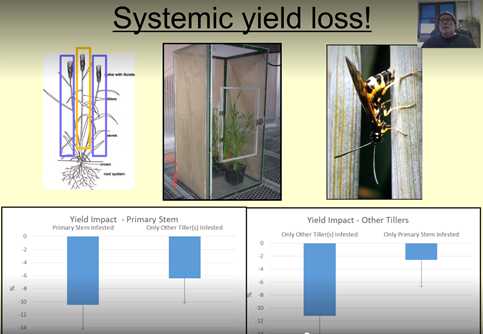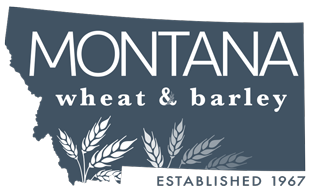Your checkoff dollars at work
The wheat stem sawfly (WSS) is the major pest of wheat grown in Montana and is a key pest throughout the northern Great Plains. Annual losses in the area impacted by the wheat stem sawfly are estimated to be at least several hundred million dollars.
There are 2 types of yield loss related to WSS:
Stem Lodging Loss typically ranges from 10-20% (or more) yield loss per field. This loss is easily seen, cut stems have tipped over, with complete heads on the ground. Seasoned WSS-effected producers are very familiar with swathers and pick up headers to help combat lodging losses. This is imperfect, and growers should go to fields well after harvest to assess the success of this operation. Cut stems with heads laying on the ground are unrecovered losses.

Jackson Strand
Systemic Yield Loss: 10-30% yield loss per infested stem, systemic larval feeding damage results in reduced ability of the plant to send yield components to the head, significantly impacting the ability to grain fill. The only way this type of loss is detected is by cutting open the stem and identify feeding by the WSS larvae.
How Do These Interact at Harvest? Very simply, a cut stem that makes it into the combine hopper has that 10-30% systemic yield loss built in. A cut stem remaining on the ground is 100% lost. Systemic yield loss occurs in swathed fields, no matter how excellent the harvest practice is because this loss has already happened when equipment arrives.
Why not plant the highest yielding hollow stem variety and swath? Systemic yield loss is the real problem, along with cultivation of a growing WSS population.
The charts below are the latest wrinkle – and not good news. A wheat plant typically produces about 3 stems – or tillers – per seed in a wheat field.
Because of plant architecture and plumbing, this systemic yield loss due WSS larval feeding occurs across all stems, even if only one stem is infested (3-10% loss in the uninfested stems). The way yield loss has been viewed in the past does not account for this decreased yield in the uninfested stems of an infested wheat plant. Thus, losses are greater than previously believed. It is extremely important to decrease WSS numbers across the landscape in Montana wheat and barley production.

The key strategy to combating WSS is deployment of solid stem varieties, coupled with continuing development of superior host plant resistance. The small larvae struggle to survive in a more solid stem resulting in greater larval mortality. Typically, solid stem varieties on paper have lower yields than hollow stems. If you produce wheat in WSS impacted regions, please consider solid stems or use both solid and hollow varieties, with solid stems dedicated to the most seriously impacted areas. Hollow stems will stimulate larger WSS populations resulting in a bigger problem down the road. Contact your local seed dealer or MSU varietal specialist to develop a science based WSS management plan.
This insect can develop in most cereal crops, plus cultivated and wild grasses. Losses are typically less apparent in barley and oat is invulnerable. Recent evidence suggests that the wheat stem sawfly is probably native; yield impacts similar to here in Montana are now being seen in Colorado wheat regions. The WSS in Colorado did not come from Montana, but the reproductive cycle of native Colorado WSS has recently adapted to the wheat growth cycle there. This ongoing adaptation will continue to synchronize local WSS to wheat grown in Kansas and Oklahoma, and damaging populations will soon occur there as well.
The Montana Wheat & Barley Committee has invested Montana State University’s Wheat Stem Sawfly laboratory for the last 2 decades. Funding promising parasitoid population efforts, product development, solid stem varieties and best production practices are showing great advancements. Stem susceptibility and stem solidness have an interesting relationship, one new goal is to breed for varieties that have high stem solidness during WSS susceptibility, kill the larvae and then become hollow – for larger yields. This is all in the works for Treasure State producers, and we encourage producers to attend field days to see firsthand what the future will look like.

